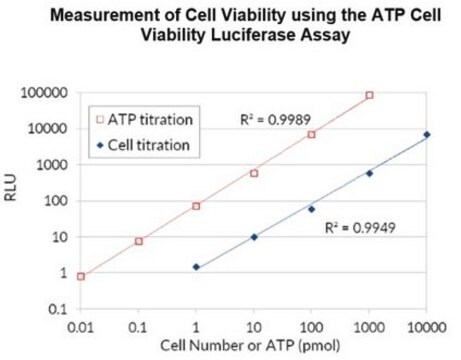おすすめの製品
品質水準
保管温度
−20°C
詳細
The Plant Cell Viability Assay Kit is designed for the differential viability staining of plant cells. The kit employs a dual color fluorescent staining system to highlight viable and non-viable cells. This procedure has been used to stain intact plant tissue, callus tissue, cell suspension culture, and protoplasts.
アプリケーション
Viable cells are living cells with intact plasma membranes. These cells can be distinguished by the presence of intracellular esterase activity. This activity is assayed through the enzymatic hydrolysis of fluorescein diacetate or related compounds, such as carboxyfluorescein or calcein AM. These lipophilic compounds are membrane-permeable and non-fluorescent. In the plant cell, they are hydrolyzed to highly polar fluorescent compounds. Because of their polar nature, these compounds are unable to diffuse across the plasma membrane and are retained within viable cells, producing an intense green fluorescence within the cytoplasm. Fluorescein diacetate was found to be the optimal dye for staining viable plant cells. It does not photobleach as quickly as calcein AM, and produces much less background fluorescence than carboxyfluorescein diacetate in plant cells. Non-viable cells could be either living or dead. They can be distinguished from viable cells by their non-intact or damaged plasma membranes. Propidium iodide and related compounds, such as ethidium homodimers-1 and -III, can only enter cells with damaged membranes, whereupon they intercalate into double-stranded nucleic acids. This results in a bright red fluorescence in non-viable cells, particularly in the nucleus where the concentration of nucleic acids is highest. Propidium iodide is the optimal dye for staining non-viable plant cells. In plant cells it specifically labels nucleic acids, whereas ethidium homodimers-1 and -III both bind non-specifically to the plant cell wall.
その他情報
本キットの構成品は、遮光して、乾燥剤と合わせて-20°Cで保管してください。ヨウ化プロピジウムは水溶液中で安定しています。しかし、フルオレセイン二酢酸は水溶液中で加水分解します。色素は希釈後1日以内に使用してください。
保管分類コード
10 - Combustible liquids
WGK
WGK 2
引火点(°F)
188.6 °F
引火点(℃)
87 °C
適用法令
試験研究用途を考慮した関連法令を主に挙げております。化学物質以外については、一部の情報のみ提供しています。 製品を安全かつ合法的に使用することは、使用者の義務です。最新情報により修正される場合があります。WEBの反映には時間を要することがあるため、適宜SDSをご参照ください。
毒物及び劇物取締法
キットコンポーネントの情報を参照してください
PRTR
キットコンポーネントの情報を参照してください
消防法
キットコンポーネントの情報を参照してください
労働安全衛生法名称等を表示すべき危険物及び有害物
キットコンポーネントの情報を参照してください
労働安全衛生法名称等を通知すべき危険物及び有害物
キットコンポーネントの情報を参照してください
カルタヘナ法
キットコンポーネントの情報を参照してください
Jan Code
キットコンポーネントの情報を参照してください
試験成績書(COA)
製品のロット番号・バッチ番号を入力して、試験成績書(COA) を検索できます。ロット番号・バッチ番号は、製品ラベルに「Lot」または「Batch」に続いて記載されています。
この製品を見ている人はこちらもチェック
E A Brisibe et al.
Journal of experimental botany, 51(343), 187-196 (2000-08-12)
Three types of callus tissues established from anther culture of eleven doubled haploid (DH) lines of wheat (Triticum aestivum L.) were evaluated for their ability in enhancing friable embryogenic (Type II) culture differentiation and genetic transformation. Differences between types of
Estimating viability of plant protoplasts using double and single staining.
Huang, C.-N., et al.
Protoplasma, 135, 80-87 (1986)
H Koyama et al.
Journal of experimental botany, 52(355), 361-368 (2001-04-03)
The viability of Arabidopsis thaliana (strain Landsberg) roots exposed to a low pH (4.5 or 4.7) solution that contained 100 microM CaCl(2) was examined by staining with fluorescein diacetate-propidium iodide. The elongation zone of growing roots lost viability within 1-2
K H Jones et al.
The journal of histochemistry and cytochemistry : official journal of the Histochemistry Society, 33(1), 77-79 (1985-01-01)
A rapid, simultaneous double-staining procedure using fluorescein diacetate (FDA) and propidium iodide (PI) is described for use in the determination of cell viability in cell suspension. Air-dried slide preparations can be made from the cell suspensions so that an accurate
S. M. Regan et al.
The Plant cell, 2(9), 877-889 (1990-09-01)
Microsporogenesis has been examined in wild-type Arabidopsis thaliana and the nuclear male-sterile mutant BM3 by cytochemical staining. The mutant lacks adenine phosphoribosyltransferase, an enzyme of the purine salvage pathway that converts adenine to AMP. Pollen development in the mutant began
ライフサイエンス、有機合成、材料科学、クロマトグラフィー、分析など、あらゆる分野の研究に経験のあるメンバーがおります。.
製品に関するお問い合わせはこちら(テクニカルサービス)












